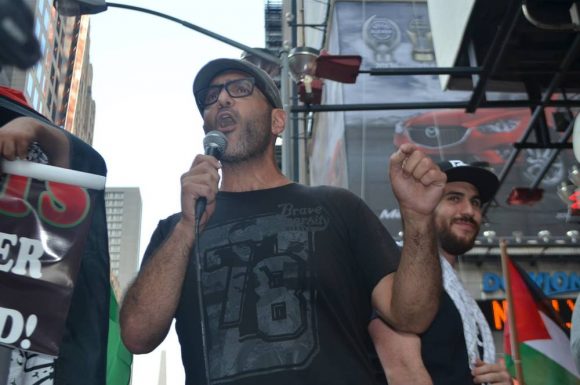
“Art actions relevant for today come from a place of vulnerability and radical love, from fighting back. They push back and it creates a little space, and that little space could be something more meaningful, if only for a second. And then you do it again. And it gives you that breath of fresh air.”
Amin Husain’s interests focus on resistance and liberation, as well as movement generated theory and practice. His research and teaching interests span debt and financialization, globalization and political economy, social movements and cultures of resistance, race, class and ethnicity in the media, and postcolonial theory. He is a founding member of Global Ultra Luxury Faction (G.U.L.F.), direct action wing of Gulf Labor Coalition; a member of Gulf Labor Coalition, a self-organized group of artists, writers, architects, curators, and other cultural workers trying to ensure worker’s rights are protected when art, labor and global capital intersect; a founding member and managing editor of Tidal: Occupy Theory, Occupy Strategy, a printed theory and strategy magazine of the Occupy movement; a founding member of MTL, a collective that combines aesthetics, research and organizing in its practice; and founding member of NYC Solidarity with Palestine.
Emily Bellor: To start, can you talk a little bit about how you got into this practice?
Amin Husain: It’s been a constant quest of trying to figure out, “where can I be most effective, where can I be engaged, in what capacity, in what medium, in what presence?” I didn’t come to a practice so much as I came looking for freedom. In this context freedom is about time and space, and is directly linked to my upbringing in Palestine. I came to the United States and pursued paths that I thought led to justice but in fact don’t. I come from a poor background; my dad finished fourth grade and my mom finished high school. No one in my family was raised an artist. So I studied philosophy and political science and then went to law school at Columbia, thinking that law is an agent of social change. But then I realized that that’s bullshit—law maintains the status quo. I practiced finance and corporate law for Wall Street clients and realized that it was just a glorified servitude. People think you’re making money but you’re getting cheated by time, giving up things that actually have the potential of making you happy—things that have the potential to make a difference—in order to be stable and lonely. So after five years of practicing law I left on my birthday and went into international photography, that’s how I met Nitasha Dhillon, and we began connecting ideas and struggles and started doing interventions—performative stuff—and that led to Occupy. And while we were in Occupy we were also in the Whitney independent study program, engaged in the art world, but we were also on the street, organizing and planning. That’s how I came to my practice.
EB: What was one of the early interventions that you and Nitasha did together?
AH: I think the first one we did together was before Occupy. We got Arabic newspapers from places that were experiencing popular uprisings and printed the front pages on 11×17 paper, translated the headlines, removed the ads, and put them in public spaces with rocks on top for people to take. Our second intervention was to supplement the findings published by the Truth and Reconciliation in South Africa. The findings were published in English, but only about 8% of the population that was under Apartheid spoke English, so we created a flow-chart of what happens to the victim’s statement throughout the translation process, and placed it as a supplement with all of the different volumes in the city.
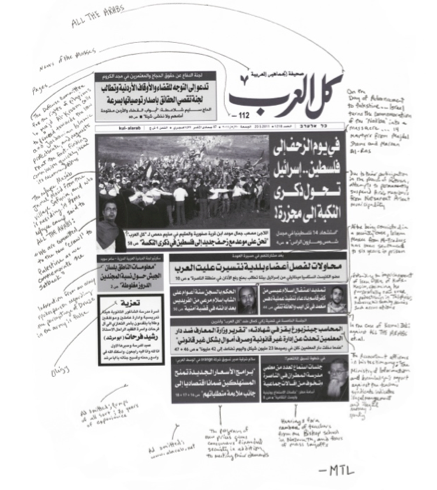
EB: So readers would get that story too.
AH: Yeah.
EB: Can you talk about a project or intervention you’ve done that you thought was particularly successful, or that you were particularly proud of?
AH: Success kind of depends on what you’d like emphasize. If you emphasize the facilitation of a space for people to get engaged that reads in the art world, then G.U.L.F. actions do that. For one of our actions against the Guggenheim we made our own art that named the trustees and placed it on the walls. We had to get into the space undetected and break up into groups, and people put media they’d created themselves on the walls. It was a transgression; it caused harm to the museum and simultaneously allowed everyone to make their own art. So that’s one example. Another example that emphasizes action more so than art and organizing would be the dropping of a 90 ft. x 45 ft. banner off of the Manhattan bridge that said “Gaza in our hearts/Boycott/Divest/Sanction/Israel”. We bought all of the pieces without credit cards and worked day and night for about 20 days, studying the NYPD and researching laws around federal terrorism charges. Then we did a successful action—and never got caught.
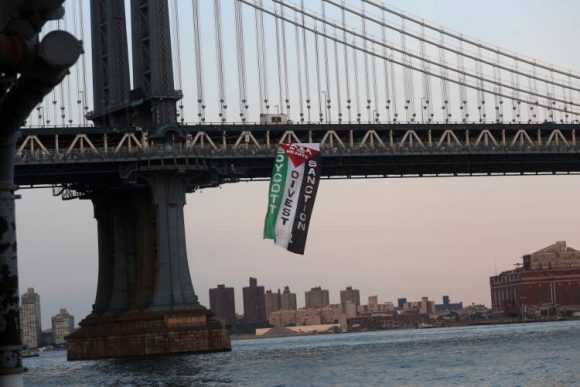
EB: So the first action against the Guggenheim was successful because it united people and allowed people to produce their own art?
AH: It was successful for multiple reasons. One: it was art in the sense that it was beautiful and it worked in the space. Two: people came and participated on an equal footing and produced their own media pieces. Three: it was a material blow to the Guggenheim. It wasn’t a symbolic action; they lost money and it hurt their brand. It contributed to strategic goals of a larger struggle.
EB: So how do you know when an action has worked?
AH: The number one metric for me is: is it beautiful? I know that’s subjective, but to me, is it beautiful? Two: did it involve a lot of people? Three: what’s the timing—does it contribute to something larger than itself? Because I’m not interested in one-off actions. I’m interested in putting my time, energy, and thought process toward something that means more than what I put in. Four: does it function in multiple spheres? Does it function in a political sphere, in an action sphere, in an artistic sphere? Because I’m not interested in those separations, I’m interested in something beyond all of them and I don’t want to choose.
EB: Of course. So do you think about your audience when you stage an intervention? And who is that audience?
AH: It’s very specific. In the context of the Guggenheim, for example, there are multiple audiences. There is the museum-goer, the museum itself—the board of trustees—, and there’s the media: how will they report the action? There are also the people participating, because as an organizer in the artistic space I was not organizing people, I was facilitating a space for people to be self-organized. So those are your four audiences. One is horizontal between us coming together and you showing up—you’re an audience—can I bring you in in a way that you’re self-activated, doing things yourself without me managing you? I’m throwing the party, but you’re going to dance. That’s the most important audience frankly, because without them nothing will happen. Then there’s the museum, and you know they’re not going to like what you’re going to do, so the question is: can you win over the museum-goers and can you win over the media? It’s the legitimacy of the action that you have to be most concerned about, so rather than think of an audience, think of the different pieces and whether they will perceive what you’re doing—which is breaking rules—as legitimate or as belligerent, as taking a cheap shot, or as anything that work to the advantage of the museum.
EB: So how do you know if the museum-goers and media have perceived the action as legitimate?
AH: You don’t leave anything to chance. There’s a lot of work on the back-end that is hardly ever present. You never know whether something is going to work or not, but you get Art America and e-flux—you know, “the jury”—to look at it, and the jury looks at it as art or as creative. Holland Carter writes about it in the New York Times, Hyperallergic covers it.
EB: Right. So what is some of the behind the scenes work you mentioned that insures nothing is left to chance?
AH: Well, let’s take the most radical thing we’ve done to the Guggenheim: occupy their museum. It’s easy to occupy a museum, it’s not easy to get away with it, to have people not think that you mistreated the museum, to have the museum-goers whose days got cancelled not hate you for ruining their day. So it took a lot of thinking. We thought about the workers in the museum and how to relay their fears, and we made them these post cards of explaining what we were doing and why. It was also really important to make the action visible outside of the museum and not just on the inside, so we organized with South Asian labor unions, workers, and community centers. We consulted with them about the action to make sure they supported it. Because we weren’t speaking on behalf of a people, we were trying to amplify a voice, and if the community disagrees then how can you do that? We sought to organize with the people we felt aligned with politically—you’re oppressed, they’re oppressed—and they said “yes, we’ll show up on May Day.” They could be anywhere in the city but they were there. So it’s difficult, then, for the Guggenheim to say that it was just a bunch of rogue artists who don’t have careers.
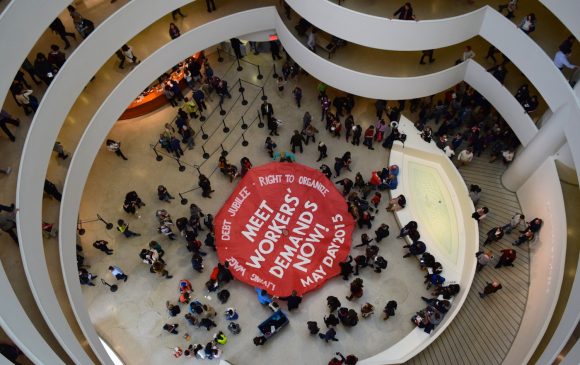
EB: When you have the support of communities it’s harder for them to twist the story that way.
AH: Right.
EB: When you do an action or put out a piece of art, what do you want your audience to do upon seeing it?
AH: Replicate it.
EB: Replicate it?
AH: What we’ve done with our actions is blend theory, analysis, and research. At the end of the day this is something that is easy to duplicate. It’s quite mechanical really. The part that isn’t mechanical is the specificity of the target or the specificity of the struggle. But everything else, in terms of leverage and organizing, is replicable. It’s funny, because when we did the actions at the Guggenheim the actions at Tate Modern took off shortly afterwards, and they very much resembled the actions we’d done at the Guggenheim. And we were so ecstatic about that. Because they crossed boundaries, they crossed borders. It’s about being inspired and about losing fear to hold our institutions accountable, as artists, as activists, and as organizers.
EB: That’s great. Going in the opposite direction now: can you talk about a project or action you’ve done that you think didn’t work?
AH: Strike Debt didn’t work. Strike Debt was a beautiful idea to maintain all of the energy and organizing around Occupy and carry it forward in an anti-capitalist way by targeting debt. And if you target debt, you level a blow at the entire system. People celebrated Strike Debt as a success, but I feel it was a failure. So we took that same energy and realized we needed to get more specific, we can’t target just capitalism, we need to target a specific institution. After a failure you think about what the problem was, and there were many problems but at the end of the day race wasn’t a central part of the analysis. And if race isn’t a central part of the analysis, you’re going to end up with something that looks better, but still maintains white supremacy.
EB: So Strike Debt didn’t maintain an intersectional focus on debt?
AH: It had an intersectional focus, but it didn’t understand how deep white supremacy was in the people that we were organizing. And I don’t mean that they’re bad people, I just mean that so often in our organizing and activism we believe that we’re the good guys—we’re the good people—and we’re not. And by the time it was done people identified Strike Debt as white supremacy. That was a problem, so that was a failure.
EB: Of course. You said a little while ago that you aren’t interested in one-off actions. So what larger project or campaign do you consider your actions to be part? The project of trying to be free, or something more specific?
AH: Both. They’re both. My engagement with Palestine is different from my engagement with South Asian migrant workers being exploited in the gulf region. It’s different from my work with Occupy. Each one of those is different. But there’s always an internal and external relationship, a dialectical process. Each of the actions I talked about were quite tangible, quite well thought out. I think there’s my strategic intervention, recognizing that whatever I’m engaged in has its own trajectory. Where we are right now, what’s happening, has its own trajectory. It’s these little moments of what can you do that could potentially have an impact greater than itself, on the outside and on the inside. Occupy did that, it was a communal experience but it also involved actions and spoke out against the state.
EB: Right.
AH: That’s the most obvious example. Occupy changed us but it also changed the conversation. It changed something that’s happening in the world in a big way. And that just happened, you never know what’s going to happen, but if there’s ten things you can do right now, then you should probably take the time and think which one promises to have a deeper impact.
EB: On both inside and outside?
AH: Right. And everyone can answer that question differently based on their practice, based on their issue.
EB: Talking about issues: what change would you like to bring about most in the world?
AH: I feel like that question comes from a place that I don’t think it’s a good question.
EB: Really, why is that?
AH: Because it comes from a place where I don’t feel like I’m a part of the problem, and I think every activist, every organizer needs to understand they’re part of the problem. The change I want bring on some level is to just be nicer to my mom and my sisters, nicer to people that are in my life. If anything, that’s probably the most tangible change I’ll be able to achieve anyway. We get old and we die fast. Connecting ourselves to something bigger and realizing, a: that we’re part of the problem, and B: that whatever we do is going to be miniscule is a good starting point for me. And in a way that question doesn’t say anything against what I just said, but I feel like it needs to be said. In terms of what I would like, I would like to see a world that is more just. In Palestine, I would like to see people there not getting killed every day. I’d like to see every person able to reach their potential. I want to see that everywhere. And I’m not going to achieve that. But I don’t want to be the person that’s contributing to this. And that means actively resisting, actively imagining, and actively undoing in ourselves.
EB: I understand what you mean. Earlier you said that you had originally practiced law because you thought law would bring social change—and then you realized that was bullshit. So what’s your theory of social change now?
AH: The power is with the people that imagine that they don’t have any power. Everyone’s sad. Everyone has a million thing things to worry about. They concern themselves with other things, they think they’re masters of their own journeys. It’s all an illusion. They think they’re well-informed. They think as if they know the truth things will change. And I think that law maintains that illusion. Once you break that illusion you create that space for people to see each other. Not that it’s utopia, there’s conflict. But I’d rather see that conflict. I’d rather spend time nurturing a better world. If people don’t consent to be governed by oppression and governed by injustice, we have at least the possibility for something else. So that’s the theory behind what I’m about to say. My theory of social change is that every little thing matters. They matter more than the thing that you think is big. Looking each other in the eye, taking time to care for each other, and reaching out and cultivating a thing outside of what they say the world for us is, stepping out, doing a thing opposite of what is expected of us. And if our actions of our and our art can do that, that’s good. And I think that’s what I’m doing. You make art, you do internet stuff, you do actions, you write, you do all of these things, but they’re all part of that one thing, you know? You push boundaries and you open up space and you make people have the space and the time to think something outside of the stupid Matrix.
EB: So what is that one thing?
AH: I think when people put art on the wall at the Guggenheim that day, they stepped out of the matrix. It opened space. It put a dent in people’s imaginations of what’s possible. Because I don’t know what’s possible, I just know that things other than what we have are, because what we have is pretty fucking bad.
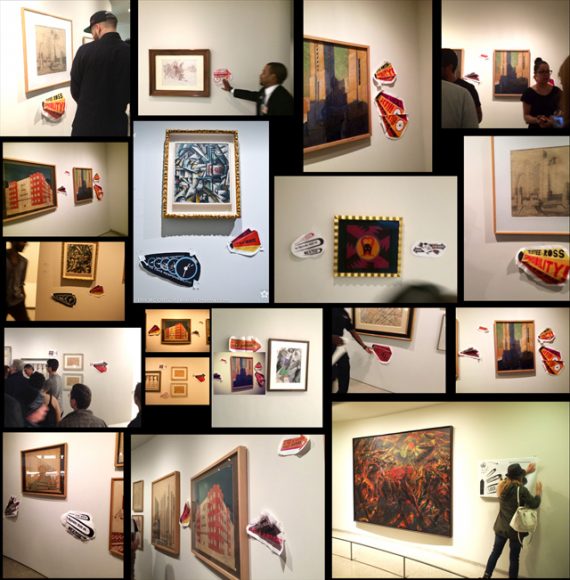
EB: You said do something outside of what “they” say the world is for us. Who is “they”?
AH: There is no word for it, you know: The Matrix, the system, the man, the power. But things have become so crazy that there isn’t one explanation or one person doing it. That’s why I say we’re part of it. The “they” is us too. But in general, it’s power. We are not free. Most of what you do you’ve been set to do since you finished high school. The way you think, the way you see.
EB: What do you mean by that?
AH: We’re never re-interrogating. We grow up with a body of knowledge that informs how we feel, informs how we see, informs our imagination. That’s why I’m interested in what can we do out in the world that helps us undo, that helps us see, that helps us imagine. You have to unpeel everything that got put on you. It’s like being in a relationship after being in an abusive one. Or growing up wanting to be free, and thinking you’re free, but you’ve weren’t free until you left for college—but when you left for college that was just a change from your parents controlling your life to a university and the state controlling your life. When have you ever been free? You have the freedom to consume, maybe the freedom to love, it depends on whether you and the person you love are free in the sense that you have time and space. We don’t know to how to be free. Which is why when you occupy a space like Zuccotti Park, people don’t know how to deal with each other.
EB: You say there were issues in Zuccotti Park because people don’t know how to be free. Do you think it’s possible? To peel back everything?
AH: We have to try. Shit’s hard; every time you think you do something little that’s awesome, remember there are thousands of years of shit you’re working against, and that’s okay, because at least your kind of putting it in perspective. That makes you live a richer life, and beautiful art follows from that, you know? At least art relevant for today. Art actions relevant for today come from a place of vulnerability and radical love, from fighting back. They push back and it creates a little space, and that little space could be something more meaningful, if only for a second. And then you do it again. And it gives you that breath of fresh air.
EB: Something all of us could use, for sure.
AH: Right. In summary, the work that I do is ultimately about training in the practice of freedom. Each one of these actions are part of that, and they’re tangible, they operate on real levels. Each action is in conversation with one another. There’s the research, the aesthetic component, and the action. Then you debrief in analysis and you continue on. You have a process, and in that process you’re on this path towards freedom and love and being engaged in life, and then you do an action and then you come back and you say “now what next?” It’s part of something bigger that involves more people, and across the globe you could inspire someone to try to do the same thing, or something different, or something better.
EB: Could you expand on the components of that process—research, aesthetics, action?
AH: I’m steering away from words like activism and words like art. Because for me, these three components are what make the practice we’re trying to talk about. Research doesn’t necessarily mean books and theory, it means investigating and understanding a situation and seeing how it links to your own life and what you’re doing. Once you position yourself in relation to the thing you care about most you say “what can I do that will look beautiful?” Because you’re trying to embody the world you want to see, well don’t we want to see that fucking world beautiful?
So then you say, “what kind of action can I do that is beautiful and that is well-researched?”, and you do it. And then you say: “what have I learned and how does it change me?” Then you say, “now what”?



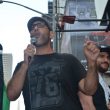
You must be logged in to post a comment.